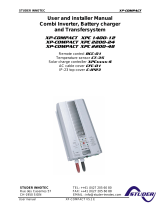
-16-
XII Services
If the charger has quality problems, you can change a new one within two months, and can be
repaired within one year free of charge. If the fault is caused by follow reasons, it cannot be
repaired free of charge:
(1) Damage caused by illegal operation.
(2) Without authorization, open the shell or repair, lead to damage.
(3) Damage caused by improper transportation, such as knocking, collision, or falling.
(4) Damage caused by water inlet, immersion, damp or other irresistible natural calamities.
(5) Damage caused by instantaneous over voltage in power grid (25% higher than Rated input
voltage).
(6) Damage caused by pulling input or output cable seriously.
For better services please follow attentions below:
(1) In warranty period, if faults occur in condition that all operations are according to user’s
manual, we will replace or repair free of charge.
(2) Warranty period and maintenance mode:From date of purchase within 12 month, free of
charge to repair. Users need to pay for reparation beyond warranty period.
(3) If faults happen within warranty period in follow cases, cost of material and service need be
paid appropriately:
A.Guarantee paper does not have the seal of distributor.
B.Fault caused by improper operation.
C.Fault caused by improper safekeeping and maintenance.
D.Damages cause by accident or disaster, such as natural disaster, war, or lightning strike.
E.Guarantee paper is damaged, or cannot be distinguished clearly.
(4) Out of warranty period, users need to pay for cost of material and service, spare parts can have
guarantee for 3 month from the date of reparation.
(5) If the guarantee paper does not record purchase date, warranty period will be 12 month from
date of delivery from factory.


















